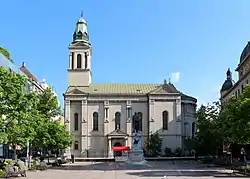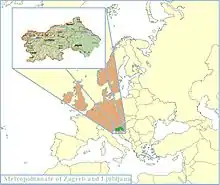Metropolitanate of Zagreb and Ljubljana
Metropolitanate of Zagreb and Ljubljana (in Serbian: Митрополија загребачко-љубљанска) is an Eastern Orthodox eparchy (diocese) and one of the five honorary Metropolitanates of the Serbian Orthodox Church. The headquarters of the Metropolia is located in Zagreb, Croatia and its jurisdiction covers northern Croatia and the entire territory of Slovenia.
Metropolitanate of Zagreb and Ljubljana | |
|---|---|
 | |
| Location | |
| Territory | Northern Croatia and Slovenia Italy (1994–2011) |
| Headquarters | Zagreb, Croatia |
| Statistics | |
| Population - Total | 75,000–100,000 (estimation) |
| Information | |
| Denomination | Eastern Orthodox |
| Sui iuris church | Serbian Orthodox Church |
| Established | 1557 |
| Cathedral | Cathedral of Holy Transfiguration, Zagreb |
| Language | Church Slavonic Serbian |
| Current leadership | |
| Bishop | Metropolitan Porfirije |
| Map | |
 Metropolitanate of Zagreb and Ljubljana | |
| Website | |
| www | |
.JPG.webp)
History
During the Middle Ages, Slovenia was under Habsburg rule, while the neighbouring Banate of Slavonia was under the rule of Hungarian kings. Some eastern regions of medieval Slavonia were inhabited by Serbs, who settled there after fleeing Bosnia during the 15th century, even before the Ottoman conquest of Bosnia in 1463. In 1438, Pope Eugene IV sent the inquisitor Giacomo della Marca to Slavonia as a missionary to baptize "schismatic" Serbs in "Roman religion", and if that failed, to banish them.[1] In 1454, Serbian Orthodox liturgical book, the Varaždin Apostol was written in Upper-Slavonian city of Varaždin, for princess Katarina Branković of Serbia, wife of Ulrich II, Count of Celje.
In the first half of the 16th century, Slavonia was devastated by frequent wars. Eastern part (Lower Slavonia) was conquered by the Ottomans, while the western part (Upper Slavonia) came under the Habsburg rule.[2] Since the renewal of the Serbian Patriarchate of Peć in 1557, the Orthodox Serbs of Lower Slavonia were placed under jurisdiction of the Eparchy of Požega, centered at the Orahovica Monastery.[3] In 1595, Serbian Orthodox metropolitan Vasilije of Požega moved to Upper Slavonia, under Habsburg rule, in order to avoid the Turkish oppression.[1] His successors were headquartered in the Marča Monastery. In those areas, Serb migrants served as soldiers of the Varaždin Generalate. During the 17th century, bishops of Marča led the difficult fight against Roman Catholic proselytism.
In addition to Marča Monastery, the other spiritual center of Orthodox Serbs in the area was and still is Lepavina Monastery. Abbot Kondrat of Lepavina was killed in 1716, defending the purity of Orthodox faith. He was killed by those Serbs who had become Catholics. In 1734 the headquarters moved to a monastery at Lepavina and the Diocese was called "Eparchy of Lepavina". Serbian Orthodox bishop Simeon Filipović of Lepavina (1734-1743) also had residence in Sjeverin. After his death and several years of administration, Eparchy of Lepavina was abolished and in 1750 its territory came under jurisdiction of Serbian Orthodox bishops of Kostajnica. In 1771, the region came under jurisdiction of Orthodox Bishops of Pakrac, and that remained until 1931.
20th century
Soon after the creation of Kingdom of Serbs, Croats and Slovenes (1918), all Serbian Orthodox ecclesiastical provinces were merged into united Serbian Orthodox Church in 1920. Since the city of Zagreb was second capital of the Kingdom, initiative was revived for the restoration of old "Eparchy of Lepavina" under newly proposed name "Eparchy of Zagreb". After long preparations, the region was detached from the Eparchy of Pakrac in 1931, and new Serbian Orthodox Eparchy of Zagreb was created, with its Bishop receiving the honorary title of Metropolitan.[4]
First Eastern Orthodox Metropolitan of Zagreb was Dositej Vasić, a learned theologian, and man of broad vision and understanding in relations with other nations and religions. In spite of that, after the Nazi occupation of Yugoslavia in World War II and creation of Independent State of Croatia (1941) he was arrested and tortured. As a consequence, he died in 1945, exiled from his eparchy.[5]
After World War II, the Zagreb Metropolitanate and the other Dioceses in the territory of Croatia were administered by auxiliary (vicarian) bishop Arsenije Bradvarević. He was succeeded by Damascus Grdanički, previously Bishop of Banat, and after his death in 1969, the Metropolitanate was administered by the Bishop of Slavonia, Emilian Marinović.
At the regular session of the Holy Assembly of Serbian Orthodox Church in the 1977, the spiritual guidance of this Metropolitanate is entrusted to vicarian bishop Jovan Pavlović of Lepavina, who was elected for Metropolitan of Zagreb in 1982. Next year, the name of eparchy was expanded into Eparchy of Zagreb and Ljubljana. On the proposal of the Metropolit Jovan, the name of eparchy was expanded once more in 1994 into "Metropolitanate of Zagreb-Ljubljana and all Italy". Jurisdiction over Serbian Orthodox churches in Italy, that was transferred to the Metropolitanate in 1994, lasted until 2011.[6]
Metropolit Jovan organized the meeting of Serbian Patriarch Pavle and Cardinal Franjo Kuharić (first in the spring of 1991 in Sremski Karlovci, and the other later in Slavonski Brod). He also organized a meeting of Patriarch Pavle and the Croatian President Franjo Tuđman.
In 2014, bishop Porfirije Perić was elected Metropolitan of Zagreb and Ljubljana and enthroned in Zagreb on 13 July by Serbian Patriarch Irinej.[7]
Bishops and metropolitans
Orthodox bishops and metropolitans who had jurisdiction over the territory of present-day Metropolitanate of Zagreb and Ljubljana
Bishops of Marča
- Maksim Predojević (1630–1642)
- Gavrilo Predojević (1642–1644)
- Vasilije Predojević (1644–1648)
- Sava Stanislavić (1648–1661)
- Gavrilo Mijakić (1661–1671)
Since 1705, under jurisdiction of Orthodox Bishops of Pakrac.
Eparchy of Lepavina
- Simeon Filipović (1734–1743)
- (1743-1750) administration
Bishops of Kostajnica
- Arsenije Teofanović (1750–1753)
- Josif Stojanović (1754–1771)
After 1771, again under jurisdiction of Bishops of Pakrac.
Metropolitans, since 1931
- Dositej Vasić (1931–1945)
- Arsenije Bradvarević (1945–1947), administration
- Damaskin Grdanički (1947–1969)
- Emilijan Marinović (1969–1977), administration
- Jovan Pavlović (1977–2014)
- Porfirije Perić (2014–present)
See also
- Serbs of Croatia
- Eastern Orthodoxy in Croatia
- List of the Eparchies of the Serbian Orthodox Church
References
- Mileusnić 1997, p. 113.
- Ćirković 2004, p. 118.
- Ćirković 2004, p. 119.
- Constitution of the Serbian Orthodox Church
- Saint Dositej Vasić of Zagreb
- Metropolitan Jovan (Pavlović) of Zagreb-Ljubljana reposed in the Lord
- SOC (2014): Enthronement of His Grace Bishop Dr. Porfirije of Jegar to the throne of Metropolitans of Zagreb-Ljubljana
Sources
- Bataković, Dušan T., ed. (2005). Histoire du peuple serbe [History of the Serbian People] (in French). Lausanne: L’Age d’Homme.
- Ćirković, Sima (2004). The Serbs. Malden: Blackwell Publishing.
- Mileusnić, Slobodan (1997). Spiritual Genocide: A survey of destroyed, damaged and desecrated churches, monasteries and other church buildings during the war 1991-1995 (1997). Belgrade: Museum of the Serbian Orthodox Church.
- Miller, Nicholas J. (1997). Between Nation and State: Serbian Politics in Croatia Before the First World War. Pittsburgh: University of Pittsburgh Press.
- Vjerske zajednice u Hrvatskoj, Zagreb: Prometej, 2008. (in Croatian)
- Вуковић, Сава (1996). Српски јерарси од деветог до двадесетог века (Serbian Hierarchs from the 9th to the 20th Century). Евро, Унирекс, Каленић.
- Raković, Aleksandar (2013). "Short Existence of the Faculty of Eastern Orthodox Theology at the University of Zagreb 1920-1924" (PDF). Теолошки погледи. 46 (3): 951–956.
External links
- Official website; accessed 6 June 2015. (in Serbian)
- Lepavina monastery webpage; accessed 6 June 2015. (in Croatian)
- The Serbs in the Former SR of Croatia
- His All-Holiness Ecumenical Patriarch Bartholomew in Zagreb
- Spiritual Genocide: The Diocese of Zagreb-ljubljana


